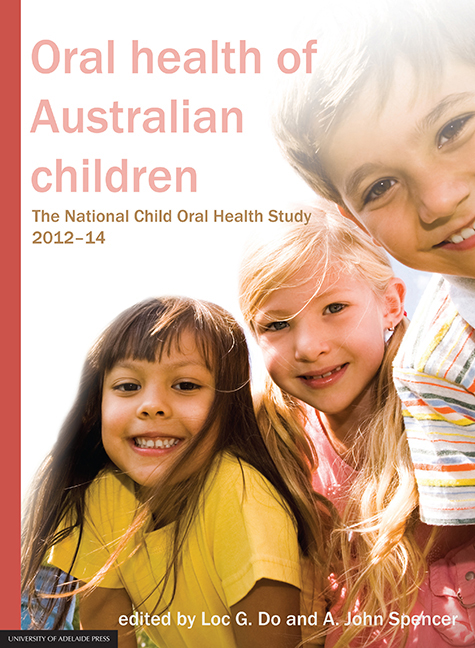Book contents
- Frontmatter
- List of Contributors
- Contents
- Preface
- Executive Summary
- 1 Children's oral health – assessing and improving oral health
- 2 Measuring child oral health and its influences
- 3 Data weighting, consideration and estimation procedures
- 4 Measuring representativeness of the study participants
- 5 Children's oral health status in Australia, 2012–14
- 6 Patterns of dental services use by Australian children
- 7 Australian children's oral health behaviours
- 8 Australian children's general health behaviours
- 9 Social gradients in child oral health
- 10 Oral health status and behaviours of Indigenous Australian children
- 11 Trends in child oral health in Australia
- 12 Interpretation of findings and a way forward to improving oral health and dental care
- 13 Appendix
- State and territory survey personnel
- Symbols
- Abbreviations
- Place names
- Glossary
- List of tables
- List of figures
2 - Measuring child oral health and its influences
Published online by Cambridge University Press: 05 September 2017
- Frontmatter
- List of Contributors
- Contents
- Preface
- Executive Summary
- 1 Children's oral health – assessing and improving oral health
- 2 Measuring child oral health and its influences
- 3 Data weighting, consideration and estimation procedures
- 4 Measuring representativeness of the study participants
- 5 Children's oral health status in Australia, 2012–14
- 6 Patterns of dental services use by Australian children
- 7 Australian children's oral health behaviours
- 8 Australian children's general health behaviours
- 9 Social gradients in child oral health
- 10 Oral health status and behaviours of Indigenous Australian children
- 11 Trends in child oral health in Australia
- 12 Interpretation of findings and a way forward to improving oral health and dental care
- 13 Appendix
- State and territory survey personnel
- Symbols
- Abbreviations
- Place names
- Glossary
- List of tables
- List of figures
Summary
Study population and sampling
The target population for the Survey was Australian children aged 5–14 years. To draw a representative sample of children from this target population a stratified two-stage sample design was implemented within each state/territory. In the first stage, schools were selected from a sampling frame of schools located within each jurisdiction. In the second stage, children were sampled from each selected school.
The sampling strategy was designed to derive accurate population estimates of the oral health of Australian children, and to make valid comparisons between the oral health of children across regions within each state. For New South Wales, Victoria and Queensland, the geographical regions were based on Area Health Services/Health Districts, while in the remaining jurisdictions they were based on Capital City/Rest of State. As a consequence, the sampling methodology differed slightly for each jurisdiction.
To sample children across the age range of 5–14 years both primary and secondary schools were in scope of the Survey. A sampling frame of schools was created from a list provided by each jurisdiction which included all public, catholic and independent primary and secondary schools. Information provided on the sampling frame for each school included school code, school name and address, school type, school enrolment and health district.
Schools were excluded from the sampling frame if they were:
• located in very remote locations that would be difficult to access by the mobile dental clinic van
• special schools
• small school enrolment (usually <50 students).
New South Wales
In New South Wales (NSW), there were 2,995 schools that were considered in scope with 2,087 primary only, 567 secondary only and 341 combined primary/secondary schools. Schools on the sampling frame were stratified into 15 regions based on NSW Local Health Districts (LHD). The number of primary and secondary schools selected from each LHD was determined by the region's percentage share of total school enrolment. For primary schools, enrolment was defined as children enrolled in year levels Kindergarten to Year 6. For secondary schools, enrolment was defined as children enrolled in year levels 7–9.
- Type
- Chapter
- Information
- Oral Health of Australian ChildrenThe National Child Oral Health Study 2012-14, pp. 15 - 34Publisher: The University of Adelaide PressPrint publication year: 2016



